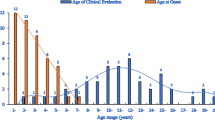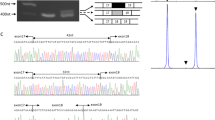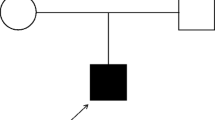Abstract
Duchenne and Becker Muscular Dystrophy (DMD and BMD) are caused, in the majority of cases, by deletions in the dystrophin gene (DMD). Here we describe the unprecedented case of a BMD patient carrying a large out-of-frame intragenic deletion, together with an inversion in the DMD gene, resulting in the inclusion of a novel exon in the transcript. Multiplex PCR amplification revealed the presence of a 48–52 exon deletion, but transcript analysis identified two unexpected products, neither of them including exon 53. The shorter mRNA derived from the juxtaposition of exons 47–54 (in-frame), while the longer one resulted from the inclusion of a novel 73-bp exon between exons 47 and 54. Sequence analysis revealed that the inserted sequence derived from an inverted portion of intron 53; its inclusion is predicted to determine protein truncation. The presence of a genomic inversion involving exon 53 and flanking regions was confirmed, and inversion/deletion breakpoints were sequenced. The inverted 73-bp sequence displays splicing signals at both ends and thus it is probably recognized as a novel exon when the partially inverted hnRNA is processed. These findings highlight the importance of mRNA analysis on patients that, based on routine DNA screenings, do not follow the reading-frame rule. This is the first reported patient carrying both an intragenic deletion and inversion in the DMD locus. This case might provide further insight into both the mechanisms that determine genomic rearrangements in the DMD locus and the molecular signals that drive exon inclusion.





Similar content being viewed by others
References
Ahn AH, Kunkel LM (1993) The structural and functional diversity of dystrophin. Nat Genet 3:283–291
Beggs AH, Koenig M, Boyce FM, Kunkel LM (1990) Detection of 98% of DMD/BMD gene deletions by polymerase chain reaction. Hum Genet 86:45–48
Chamberlain JS, Gibbs RA, Rainer JE, Nguye PN, Caskey CT (1988) Deletion screening of the Duchenne muscular dystrophy locus via multiplex DNA amplification. Nucleic Acids Res 16:11141–11156
Chelly J, Gilgenkrantz H, Hugnot JP, Hamard G, Lambert M, Recan D, Akli S, Cometto M, Kahn A, Kaplan JC (1991) Illegitimate transcription. Application to the analysis of truncated transcripts of the dystrophin gene in nonmuscle cultured cells from Duchenne and Becker patients. J Clin Invest 88:1161–1166
den Dunnen JT, Grootscholten PM, Bakker E, Blonden LA, Ginjaar HB, Wapenaar MC, van Paassen HM, et al (1989) Topography of the Duchenne muscular dystrophy (DMD) gene: FIGE and cDNA analysis of 194 cases reveals 115 deletions and 13 duplications. Am J Hum Genet 45:835–847
Dubowitz V (1985) Muscle biopsy, a practical approach, 2nd edn. Baillière Tindall, Philadelphia
Koenig M, Beggs AH, Moyer M, Scherpf S, Heindrich K, Bettecken T, Meng G, et al (1989) The molecular basis for Duchenne versus Becker muscular dystrophy: correlation of severity with type of deletion. Am J Hum Genet 45:498–506
Koenig M, Monaco AP, Kunkel LM (1988) The complete sequence of dystrophin predicts a rod-shaped cytoskeletal protein. Cell 53:219–228
Krawczak M, Reiss J, Cooper DN (1992) The mutational spectrum of single base-pair substitutions in mRNA splice junctions of human genes: causes and consequences. Hum Genet 90:41–54
Liu HX, Zhang M, Krainer AR (1998) Identification of functional exonic splicing enhancer motifs recognized by individual SR proteins. Genes Dev 12:1998–2012
Liu HX, Chew SL, Cartegni L, Zhang MQ, Krainer AR (2000) Exonic splicing enhancer motif recognized by human SC35 under splicing conditions. Mol Cell Biol 20:1063–1071
Love DR, England SB, Speer A, Marsden RF, Bloomfield JF, Roche AL, Cross GS, et al (1991) Sequences of junction fragments in the deletion-prone region of the dystrophin gene. Genomics 10:57–67
McNaughton JC, Cockburn DJ, Hughes G, Jones WA, Laing NG, Ray PN, Stockwell PA, et al (1998) Is gene deletion in eukaryotes sequence-dependent? A study of nine deletion junctions and nineteen other deletion breakpoints in intron 7 of the human dystrophin gene. Gene 222:41–51
Nicholson LV, Davison K, Falkous G, Harwood C, O’Donnell E, Slater CR, Harris JB (1989a) Dystrophin in skeletal muscle. I. Western blot analysis using a monoclonal antibody. J Neurol Sci 94:125–136
Nicholson LV, Davison K, Johnson MA, Slater CR, Young C, Bhattacharya S, Gardner-Medwin D, et al (1989b) Dystrophin in skeletal muscle. II. Immunoreactivity in patients with Xp21 muscular dystrophy. J Neurol Sci 94:137–146
Nobile C, Toffolatti L, Rizzi F, Simionati B, Nigro V, Cardazzo B, Patarnello T, et al (2002) Analysis of 22 deletion breakpoints in dystrophin intron 49. Hum Genet 110:418–421
Oudet C, Hanauer A, Clemens P, Caskey T, Mandel JL. (1992) Two hot spots of recombination in the DMD gene correlate with the deletion prone regions. Hum Mol Genet 1:599–603
Pfeiffer P, Thode S, Hancke J, Vielmetter W (1994) Mechanisms of overlap formation in nonhomologous DNA end joining. Mol Cell Biol 14:888–895
Povey S, Lovering R, Bruford E, Wright M, Lush M, Wain H (2001) The HUGO Gene Nomenclature Committee (HGNC). Hum Genet 109:678–680
Roth DB, Porter TN, Wilson JH (1985) Mechanisms of nonhomologous recombination in mammalian cells. Mol Cell Biol 5:2599–2607
Sironi M, Pozzoli U, Cagliani R, Giorda R, Comi GP, Bardoni A, Menozzi G, et al (2003) Relevance of sequence and structure elements for deletion events in the dystrophin gene major hot-spot. Hum Genet 112:272–288
Sun H, Chasin LA (2000) Multiple splicing defects in an intronic false exon. Mol Cell Biol 20:6414–6425
Toffolatti L, Cardazzo B, Nobile C, Danieli GA, Gualandi F, Muntoni F, Abbs S, et al (2002) Investigating the mechanism of chromosomal deletion: characterization of 39 deletion breakpoints in introns 47 and 48 of the human dystrophin gene. Genomics 80:523–530
Wheway JM, Yau SC, Nihalani V, Ellis D, Irving M, Splitt M, Roberts RG (2003) A complex deletion-inversion-deletion event results in a chimeric IL1RAPL1-dystrophin transcript and a contiguous gene deletion syndrome. J Med Genet 40:127–131
Winnard AV, Klein CJ, Coovert DD, Prior T, Papp A, Snyder P, Bulmann DE, et al (1993) Characterization of translational frame exception patients in Duchenne/Becker muscular dystrophy. Hum Mol Genet 2:737–744
Winnard AV, Mendell JR, Prior T, Florence J, Burghes HM (1995) Frameshift deletions of exons 3–7 and revertant fibers in Duchenne muscular dystrophy: mechanisms of dystrophin production. Am J Hum Genet 56:158–166
Yelin R, Dahary D, Sorek R, Levanon EY, Goldstein O, Shoshan A, Diber A, et al (2003) Widespread occurrence of antisense transcription in the human genome. Nat Biotechnol 21:379–386
Acknowledgements
We are grateful to Drs. R. Giorda, M.C. Bonaglia and M.T. Bassi for useful discussion about the paper. We especially thank Dr. U. Pozzoli for CV and ESE score calculation.
Author information
Authors and Affiliations
Corresponding author
Additional information
Nucleotide sequence data reported are available in the DDBJ/EMBL/GenBank databases under the accession numbers AY549479 and AY549479
Rights and permissions
About this article
Cite this article
Cagliani, R., Sironi, M., Ciafaloni, E. et al. An intragenic deletion/inversion event in the DMD gene determines a novel exon creation and results in a BMD phenotype. Hum Genet 115, 13–18 (2004). https://doi.org/10.1007/s00439-004-1118-6
Received:
Accepted:
Published:
Issue Date:
DOI: https://doi.org/10.1007/s00439-004-1118-6




